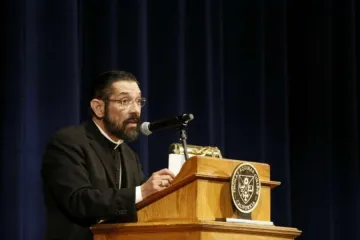Rome Newsroom, Apr 26, 2023 / 07:07 am
The Vatican announced Wednesday that there will be laypeople participating as voting members in the Synod on Synodality’s October assembly, a break with past custom, which allowed laypeople to participate without the right to vote.
Pope Francis will also approve every member in advance.
The general assembly of the Synod on Synodality will take place in two sessions, in October 2023 and October 2024.
After the vote on a final document for the assembly, the pope alone decides whether to take any actions based on the recommendations in the final text or whether to adopt it as an official Church document.
The leadership of the synod released information in a FAQ sheet April 26 about who will attend the 16th Ordinary General Assembly of the Synod of Bishops in October and how they will be chosen.
The biggest change announced Wednesday was the removal of the “auditor” role. In past synods, auditors included priests, religious, and laypeople, who did not have the right to vote in synod deliberations.
Now, these 70 members, who may be priests, consecrated women, deacons, and laypeople, will be able to vote. They will be chosen by the pope from among a list of 140 people selected by the leadership of this year’s continental synod meetings.
According to the synod leadership, it is requested that “50% of [the selected people] be women and that the presence of young people also be emphasized.”
“In selecting them, account is taken not only of their general culture and prudence but also of their knowledge, both theoretical and practical, as well as their participation in various capacities in the synod process,” the FAQ sheet says.
A second change states that five women religious and five men religious will be elected to represent their institutes of consecrated life rather than 10 religious priests as in the past.
The last modification is that Pope Francis will personally choose the representatives of the Vatican dicasteries who participate in the assembly.
“It’s a change, but it’s not a revolution,” Cardinal Jean-Claude Hollerich, relator general of the Synod on Synodality, told journalists during a meeting to explain the changes April 26. “Change is normal in life, in history,” he added.
Approximately 21% of the total participation, expected to be 370 people, will be non-bishops, Hollerich explained.
Cardinal Mario Grech, the secretary general of the Synod of Bishops, said the non-bishop participants — among them priests, religious, deacons, and laypeople — “are witnesses of the memory of the process, of the itinerary, of the discernment that began two years ago.”
Grech told CNA after the meeting that the synod of bishops has asked the presidents of the continental assemblies, which took place this spring, and the leadership of the Eastern Catholic Churches, to each submit a list of 20 people, 10 men and 10 women. From these lists, Pope Francis will choose 10 members.
He said the decision to include laypeople as full members does not “undermine” the nature of the synod as a meeting of bishops.
(Story continues below)
“It will remain a synod of bishops,” he said, “but it enriches all of the Church” to have the participation of others.
The process for electing the bishops to represent the various countries will remain the same, with one small addition, Hollerich said.
Previously, countries too small to have a bishops’ conference did not have a representative at the synod, he said. Now they will each send one bishop.
The other bishops will be elected by their bishops’ conferences. The number of bishop representatives for each country is determined based on the size of the bishops’ conference. Pope Francis must also ratify the elections of bishops as members of the synod assembly.
There will also be participants with a nonvoting capacity, who are experts, facilitators, and fraternal delegates from non-Catholic faiths.
The norms regulating synods of bishops were updated by Pope Francis in 2018 in the apostolic constitution Episcopalis Communio.
According to the FAQ sheet from the Secretariat of the Synod of Bishops, the norms continue to be based on Episcopalis Communio “with some modifications and new features to the composition of the assembly and the kinds of participants.”
The document called the changes “warranted within the context of the synodal process.”
“This synodal process, initiated by the Holy Father, the ‘visible principle and foundation of unity’ of the whole Church (cf. Lumen Gentium 23), was possible because each bishop opened, accompanied, and concluded the phase of consultation of the People of God,” the FAQ sheet said.
“In this way,” it continued, “the synodal process was at the same time an act of the entire People of God and of its pastors, as ‘the visible principle and foundation of unity in their particular churches, fashioned after the model of the universal Church, in and from which churches comes into being the one and only Catholic Church’ (LG, 23).”
“It is in this perspective that one must understand the Holy Father’s decision to maintain the specifically episcopal nature of the assembly convened in Rome, while at the same time not limiting its composition to bishops alone by admitting a certain number of non-bishops as full members,” it said.






